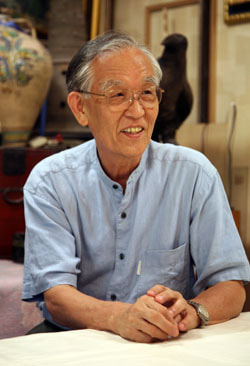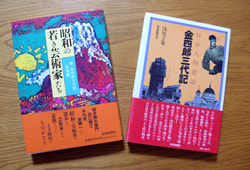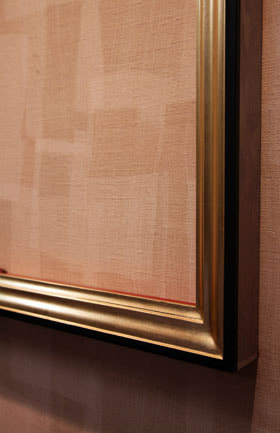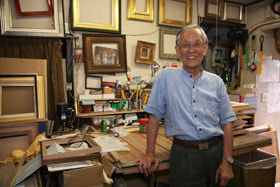
Akihito Asao

Anecdotes about artists and writers, who came and went along streets in Taito City, and the Uenosakuragi and Yanaka areas, are detailed in "Yanaka Jinbutsu Sowa - Kinshiro Sandai-ki" and "Showa no Wakaki Geijutsuka-tachi - Zoku Kinshiro Sandai-ki" (published by Geijutsu Shinbunsha) written by Teisaku Asao, who was known as Kinshiro the third of Asao Futsu-un-do.
We talked with Akihito Asao who has served as the president of Uenosakuragi-cho neighborhood association, run an art supply store and also worked as a picture restorer.
Q: Could you tell me about the origin of the store name "Asao Futsu-un-do?"
Asao: Futsu means a brush in Chinese. The founder gave the name to the store, thinking that brushes could attract people. Originally, the store was a brush store. Kinshiro Asao, the founder, opened the store in front of the Ichimura-za, a kabuki theater, in Shitaya Nicho-machi (present-day Taito 1-chome) in the Meiji Period, but the store was burnt down due to the Great Kanto Earthquake, and he transferred it to the present location, Uenosakuragi 1-chome, in 1927. At that time, he had another store in Nezu.
Q: Could you tell me about exchanges with artists?
I had a relationship with Fumio Asakura's son-in-law. Yanaka and Nezu (Bunkyo Ward) were towns of writers and artists, but they left the towns after the war (around 1955), so the number of writers and artists living in Yanaka has significantly decreased since then.
Q: What about a relationship with Koji Kinutani who is a fresco artist and had served as a professor at Tokyo University of the Arts?
He had lived in a nearby old apartment house when he was a student, and often came to visit our store. He was advised by Professor Minao Shimomura, his academic adviser, that "he should go abroad and study frescos other than oil paintings," so he went to Venice right after getting married, and stayed there for two years. The subject of his frescos, sent to Japan in the first year, was waves, and in the second year, it changed to skins of apples. When he returned to Japan, his dark paintings had changed to brighter ones. It is hard to make undercoats for frescos, so his wife helped make them, and he earnestly painted frescos. One time, his painting seemed to be dark and dull, so when I said, "Cheer up," he got angry. He thought I spoke ill of his painting. I was surprised because he said, "There is an impertinent picture framer" during his speech at a marriage ceremony of my son. However, I still owe a lot to him.
Q: What kind of scenery was in Uenosakuragi and Yanaka in the old days? In Yanaka, there is Daimyo-dokei Hakubutsukan, isn't it?
My father said that Guro Kamiguchi, the founder of Daimyo-dokei Hakubutsukan, bought pianos from evacuees during the war, sold them after the war to make a fortune, and collected feudal loads' clocks. I also heard that Ueguchi tailored clothes of Emperor Hirohito. There are also valuable Japanese-style clocks of the Edo Period in Daimyo-dokei Hakubutsukan. My father maintained close relations with Ueguchi. He was called "eccentric person" in Yanaka, and usually referred to when talking about things of old days in this area. (continued in the lower column)

Q: Teisaku Asao, the previous owner, wrote some books, including "Yanaka Jinbutsu Sowa - Kinshiro Sandai-ki" and "Showa no Wakaki Geijutsuka-tachi - Zoku Kinshiro Sandai-ki." Could you tell me a bit about him?
Those books are compilations of articles which were serialized monthly in "Geijutsu Shibun," or art newspaper, by Geijutsu Shinbunsha. My father may be the last picture framer who knew a lot about the Western painting circles. Also, I might be the only person who took over the store, and nowadays, I do not hear such anecdotes about artists. Kinshiro refers to Kinshiro Asao, the founder of Asao Futsu-un-do. The name "Kinshiro" has been handed down from generation to generation, so I am Kinshiro the fourth.
Q: What kind of scenery was in the Uenosakuragi area where the store is located?
Originally, this area was the grounds of Kan-eiji Temple, but Eiichi Shibusawa developed the area and sold it in lots. At first, a tatami store occupied this site. Originally, this site was a living quarters of a temple, and an adjacent land was a graveyard. The present townscape was formed after the Meiji Period. Kototoi Street did not extend beyond Hechima Temple (Jomyoin Temple) located at Uenosakuragi 2-chome, and the main street was right behind Yoshidaya Sake-ten (present-day Kyu Yoshidaya Sake-ten: an exhibition hall attached to the Taito City Shitamachi Museum). Districts were not clearly defined at that time, and Yanaka Hatsune-cho (present-day Yanaka) was a private land. I think Yanaka had the highest concentrations of artists in Tokyo. Tokyo Fine Arts School and Tokyo Music School (present-day Tokyo University of the Arts) were founded, so many students began to live in this area. Rich students lived in the Komagome Hayashi-cho area, but poor students in boardinghouses in this area. Also, there was a residence of the Okouchi family (Okouchi Matsudaira family) in the vicinity. I think stores selling materials for Japanese-style paintings opened in the Yanaka area after Tokyo Fine Arts School was founded in 1887.
Q: How and why did you start making brushes (brushes for Western paintings) and repairing paintings?
My grandfather was asked by Hosui Yamamoto, a Western-style painter in the Meiji Period, who organized "Seikokan," a private art school, and Seiki Kuroda, who taught at the Department of Western Painting, Tokyo Fine Arts School, to make brushes for Western paintings, turning from calligraphy brush making to Western painting. At that time, brushes for Western paintings were completely different from ones for Japanese-style paintings, so my grandfather (Kinshiro the second) devised a way to make the brushes and delivered them to customers. The brushes began to be delivered to Tokyo Fine Arts School from 1929. In some documents, in a section of Japanese culture after the Meiji Period, it is written that Asao Futsu-un-do made brushes for Western paintings for the first time in Japan. At that time, there were a few materials suitable for brushes for Western paintings. It is said that my grandfather obtained swine bristles from a company that manufactured Kamakura Ham, and made brushes experimentally. A way to make brushes had been handed down from parent to child.
Ihara, Shintaro Yamashita and Itaru Tanabe, who all graduated from Tokyo Fine Arts School and studied in France, advised my father, saying, "Western paintings created in the late Edo and Meiji Periods are going to be damaged, so you should also study methods to repair paintings." Then, may father (Teisaku) collected old paintings from antique shops, and studied the methods by himself. He was also asked by the Imperial Household Agency to repair paintings after the war, so he regularly took orders from the agency since then.(continued in the upper right column)

His techniques to repair oil paintings were designated as an Intangible Cultural Asset in Taito City (craft skills). When the Olympic Games was held in 1964, one room in the State Guest-House was used for the Olympic Committee's office. Shimizu Corporation, which was responsible for the room repair, asked my father to investigate the room condition, and he judged that the room was repairable. However, he could not contract for the work as an individual, so the Ministry of Education took charge of it, and Professor Shunichi Terada at Tokyo National University of Fine Arts and Music carried out the work. On this occasion, a conservation course was eventually set up. Later, Professor Terada painted a ceiling painting titled "Seventh Heaven" in the State Guest-House when it was renovated in 1974.
Q: When did you start making picture frames? Did you also make artist's materials?
Art supply stores started price-cutting battles around 1965. From the beginning, there were not so many painters and artists, so it became increasingly difficult to make a living. Also, it was difficult to differentiate our store from others only with artist's materials, so I turned to making picture frames. In the past, colors were made by grinding pigments by hand. We put oil and pigments on a marble slab, and ground them by hand. Color changes according to the number of times pigments were ground. When painters said, "It's OK," as they watched the grinding process, colors they wanted were made. We filled tubes with those colors, and sold them. It is not desirable to use cheap colors. However, great painters used cheap colors to paint the most part of paintings, and applied a small amount of expensive colors to finish the paintings. After all, cheap colors are thin, and are not rich, so paintings lack depth. In most cases, when painters returned to Japan after staying in foreign countries, their use of colors were slightly changed, and hues of their paintings became brighter. Maybe colors of buildings and atmosphere were different.
Q: What do you think of the tendency of recent students at Tokyo University of the Arts?
Recent students have little individuality. In the past, there were many eccentric students, some of who danced without any clothes on in front of the fountain in Ueno Park, and they had self-assertiveness in their own ways. Recently, they do not praise and criticize other people's paintings, and do not eagerly research materials. They might be exhausted only by the entrance exam. Also, they try to sell their paintings after entering to Tokyo University of the Arts. If art dealers pay 10,000 or 20,000 yen, they gladly sell their paintings. I often said to them, "Do not sell your paintings until you are 40. First of all, you should study and accumulate skills and knowledge." However, art dealers immediately bought their paintings during the previous bubble economy, so their paintings were gone. Dealers took 20 to 30 paintings, and that's it. In order to rise to national prominence, they should show about 500 paintings. Students go along on the right track if they paint because they really like to paint.
Q: Are there distinguished people who lived in this area when they were students?
Kaii Higashiyama, a Japanese-style painter, and Takeshi Hayashi, a Western-style painter, lived in this area. Our store set up "Pour Vous Model Agency" after the war, so sometimes those painters arranged about 10 nude models on the second floor, and drew from them while drinking sake.
Q: What about situations of art supply stores in the Uenosakuragi and Yanaka areas? Also, what about picture framers?
There are two stores selling materials for Japanese-style paintings, and they still stay in business. There were about three stores that made picture frames across the country in prewar days, but most frame shops that made frames by hand were closed after the war. Just because frames were made by hand does not mean that they fetched a high price. Ornaments on frames were made from plaster molds, but nowadays there are few engravers. All of them are old. I do not have samples of frames. Each picture frame is different because its shape and design is decided after seeing actual paintings. A particular frame only fits one painting. Not so long ago, some frame stores used relatively large machines to made frames on an extensive scale, but most of them were closed after the bubble economy. (continued in the lower column)

At Asao's picture frame studio
Nowadays, I take orders and make frames through direct relationships with art dealers, department stores and painters. There was a painter who said, "If your father (Teisaku) dies, I do not set my paintings in frames other than those made by you." However, recent painters do not complain even if their paintings are put in cheap frames after they are told by art dealers that it is not feasible to set paintings in expensive frames. If paintings are precious to painters, they should set their paintings in good frames. It was often the case that when a struggling painter sets his paintings in frames, all the paintings were sold. Frames make paintings more beautiful. Painters should understand that. Recent students at Tokyo University of the Arts have asked me to make frames for their paintings (227.3 x 181.8 cm) created for graduation for 50,000 to 60,000 yen. Our frames are about 200,000 yen. When I said, "It is better to make your frame at a store which you previously asked," a student relied, "The store was closed." Therefore, I sometimes repainted ready-made frames for students. Although we unintentionally pay attention to frames while looking at paintings, it is not appropriate to only see frames while facing paintings. The best thing is to appreciate paintings without noticing frames. Frames that stand out are out of the question. If paintings are set in good frames, only the impressions of the paintings are left. Also, it is necessary to design a frame after judging whether a painter wants to emphasize the foreground or distant view. If the painters' intentions are emphasized, the paintings look better. Recently, there are few people who can tell genuine paintings. Some painters think that frames make no difference and that all they need to do is set their paintings in any frames. Recent students also think that they can hang their paintings without frames. They think their paintings look good in that way, but there is something lacking in their paintings. Frames compensate for it. If they do not compensate for it, they are going to show paintings, only 70% of which is completed.(continued in the next page)

Akihito Asao

Anecdotes about artists and writers, who came and went along streets in Taito City, and the Uenosakuragi and Yanaka areas, are detailed in "Yanaka Jinbutsu Sowa - Kinshiro Sandai-ki" and "Showa no Wakaki Geijutsuka-tachi - Zoku Kinshiro Sandai-ki" (published by Geijutsu Shinbunsha) written by Teisaku Asao, who was known as Kinshiro the third of Asao Futsu-un-do.








